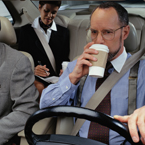Carpools aren’t just for kids anymore--more and more, adult students and
professionals are organizing carpools to share resources, save money on gas and
parking, and reduce the environmental burden of multiple-car journeys. With
more and more drivers on the roads and congestion at an all-time high, the
daily commute can be extremely stressful, particularly at peak times, and
carpooling can be a great way to alleviate this stress.
In order to get the most benefit from a carpool, careful organization is
critical. There are a number of different areas that will contribute to the
success or failure of your carpool, so take time to plan carefully. Follow
these tips from our team at
Sheehy Nissan of Glen Burnie to create
the best carpool possible.
1. You should set out to define the target group of people that you wish to
include in your carpool. It may be based around your workplace, your child’s
school, or simply based on a particular route that many drivers use. How you
set about attracting people to your carpool will depend entirely on these considerations.
In the workplace or for your child’s school, you will have a fixed location in
which you can advertise and manage membership. In other cases, you may need to
manage the pool online and via email. Online tools exist that can help you find
and make contact with interested drivers.
2. Establish criteria for the membership of your carpool. It is important
that all members are treated equally within the scheme and that, conversely,
everyone contributes to the same extent. You will need to set ground rules
around the expected frequency with which people will drive, for example, and
whether you will accept non-drivers into the group. You must define any
financial commitments that members must make. Non-drivers, for example, may
need to contribute towards gas costs. There may be a need for different
insurances. You may even wish to ask members to contribute towards coffees and
treats en route. There will also need to be penalties for non-attendance or
failing to meet commitments.
3. Construct a plan around the initial membership. Clearly identify the days
and times members are available and then establish a schedule for driving and
non-driving. You may wish to make this more or less flexible according to the
needs of your members. Always include a contingency plan, so that there is
cover in the event of sickness or holidays. Ensure that a schedule of
maintenance is included for all the cars in the pool, such that vehicles are
regularly maintained and can support the group commitments. You may be able to
secure a discount with your local dealerships if you can guarantee business
from a number of different vehicles. Make sure your plan is shared with
everyone in the group and can be easily accessed at all times.
4. Agree on carpooling etiquette. If you have a mixture of smokers and
non-smokers, then you need to establish ground rules that meet everybody’s
needs. You will also want to consider things like eating and drinking in the
car. Who is responsible for collecting and disposing of litter? Music tastes
vary wildly, so you need to establish some form of etiquette that caters to
everybody, perhaps agreeing to listen to a commercial radio station instead. It
may be a good idea to designate a carpool manager to whom suggestions and
comments can be raised.
5. Make sure that there is a mechanism for reviewing and changing the plan.
This might include short-term needs such as disruption to a route through road
works. Other longer-term changes will include somebody leaving the group, or
changing their patterns of movement. You may also want to consider how you
track the benefits of your carpool, through mileage and gas saved. This can be
a great way to encourage people to join or to maintain their commitment.
Driving is stressful and expensive, and pooling resources can be of enormous
benefit. Use these tips to organize a carpool and help reduce the costs and the
impact on the environment of your daily commute.



